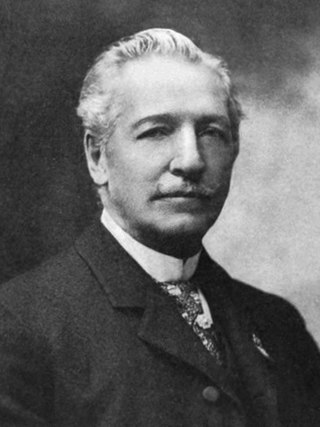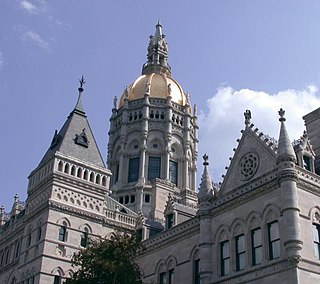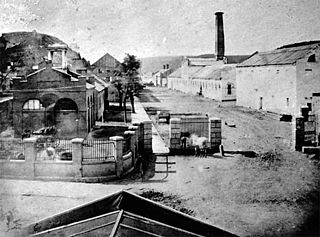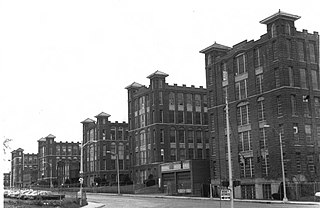
Hartford is the capital city of the U.S. state of Connecticut. The city, located in Hartford County, Connecticut, United States, had a population of 121,054 as of the 2020 Census. Hartford is the largest city in the Capitol Planning Region and the core city of the Greater Hartford metropolitan area.

Samuel Colt was an American inventor, industrialist, and businessman who established Colt's Patent Fire-Arms Manufacturing Company and made the mass production of revolvers commercially viable.

Colt's Manufacturing Company, LLC is an American firearms manufacturer, founded in 1855 by Samuel Colt and now a subsidiary of Czech holding company Colt CZ Group. It is the successor corporation to Colt's earlier firearms-making efforts, which started in 1836. Colt is known for the engineering, production, and marketing of firearms, most especially between the 1850s and World War I, when it was a dominating force in its industry and a seminal influence on manufacturing technology. Colt's earliest designs played a major role in the popularization of the revolver and the shift away from single-shot pistols. Although Samuel Colt did not invent the revolver concept, his designs resulted in the first very successful model.

The Springfield Armory, more formally known as the United States Armory and Arsenal at Springfield located in the city of Springfield, Massachusetts, was the primary center for the manufacture of United States military firearms from 1777 until its closing in 1968. It was the first federal armory and one of the first factories in the United States dedicated to the manufacture of weapons. The site is preserved as the Springfield Armory National Historic Site, Western Massachusetts' only unit of the national park system. It features the world's largest collection of historic American firearms.
Elisha King Root was a Connecticut machinist, inventor, and President of Colt's Manufacturing Company.

Charles Ethan Billings (1834–1920) was an American mechanical engineer, inventor, superintendent, and businessman. He held various U.S. patents on hand tools, either assigned or licensed to the firm that he and Christopher M. Spencer cofounded, the Billings & Spencer Company. His name as patent holder is stamped on countless forged hand tools, many of which survive. Billings was an expert in drop forging and was an influential leader in the American system of manufacturing and its successor systems of mass production for firearms, sewing machines, hand tools, bicycles, and other goods. He served as president of the American Society of Mechanical Engineers in 1895 and 1896. The Billings & Spencer Company was both a machine tool builder and a manufacturer of hand tools made with its machine tools.

United States Fire-Arms Manufacturing Company, Inc. was a privately held firearms-manufacturing firm based in Hartford, Connecticut. Until 2011, United States Fire-Arms Manufacturing Company, Inc. was known for producing single action revolvers, which were clones of the Colt Single Action Army revolver. The factory was located "Under the Blue Dome", in the East Armory building of the former Colt Armory complex, where Colt's Manufacturing Company produced many of their classic firearms in the late 19th and early 20th centuries.

The American Precision Museum is located in the renovated 1846 Robbins & Lawrence factory on South Main Street in Windsor, Vermont. The building is said to be the first U.S. factory at which precision interchangeable parts were made, giving birth to the precision machine tool industry. In recognition of this history, the building was declared a National Historic Landmark in 1966. In 1987, the building was recognized by the American Society of Mechanical Engineers as an International Heritage Site, and the collection was recognized as an International Heritage Collection. For each of these designations, the armory was considered a site where pivotal events occurred in the history of American industry, as well as a place that lends itself to comprehensive interpretation of that history.

The neighborhoods of Hartford, Connecticut in the United States are varied and historic.
The history of Connecticut Industry is a major part of the history of Connecticut. Between the birth of the U.S. patent system in 1790 and 1930, Connecticut had more patents issued per capita than any other state; in the 19th century, when the U.S. as a whole was issued one patent per three thousand population, Connecticut inventors were issued one patent for every 700–1000 residents. Connecticut's first recorded invention was a lapidary machine, by Abel Buell of Killingworth, in 1765.

The Harpers Ferry Armory, more formally known as the United States Armory and Arsenal at Harpers Ferry, was the second federal armory created by the United States government; the first was the Springfield Armory. It was located in Harpers Ferry, Virginia, which since 1863 has been part of West Virginia. It was both an arsenal, manufacturing firearms, and an armory, a storehouse for firearms. Along with the Springfield Armory, it was instrumental in the development of machining techniques to make interchangeable parts of precisely the same dimensions.

Armsmear, also known as the Samuel Colt Home, is a historic house located at 80 Wethersfield Avenue in Hartford, Connecticut. It was the family home of firearm manufacturer Samuel Colt. Armsmear was listed as a National Historic Landmark in 1976; this designation was expanded in 2008 to form the Coltsville Historic District, a National Historic Landmark District.
Robert Hillberg was a firearm designer and the head of Research & Development at the High Standard Manufacturing Company. His designs included the folding shotgun stock, the Whitney Wolverine lightweight pistol, Wildey .45 gas-operated pistol, COP .357 Derringer pistol, and M60 machine gun. Hillberg developed a variety of insurgency weapons, primarily multiple barrel shotguns, which could be covertly distributed to partisan forces fighting in the United States' national interests. Gun Digest editors have described Hillberg as a "national treasure."

The Church of the Good Shepherd and Parish House is an Episcopal church at 155 Wyllys Street in Hartford, Connecticut. It was commissioned by Elizabeth Jarvis Colt, the widow of Samuel Colt, and completed in 1867. The church and its associated parish house were designed by Edward Tuckerman Potter, and serve as a memorial to Samuel Colt and members of his family. The church and parish house were added to the National Register of Historic Places in 1975, and became a contributing property to the Coltsville Historic District in 2008.
The following is a timeline of the history of the city of Hartford, Connecticut, USA.

Coltsville Historic District is a National Historic Landmark District in Hartford, Connecticut. The district encompasses the factory, worker housing, and owner residences associated with Samuel Colt (1814-1862), one of the nation's early innovators in precision manufacturing and the production of firearms. It was the site of important contributions to manufacturing technology made by Colt and the industrial enterprise he created. Coltsville is a cohesive and readily identifiable 260-acre (110 ha) area, part of which was originally listed as the Colt Industrial District on the National Register of Historic Places in 1976. It was designated a National Historic Landmark in 2008.

Elizabeth Jarvis Colt was the widow and heir of firearms manufacturer Samuel Colt, founder of Colt's Manufacturing Company.

The Capewell Horse Nail Company is a historic brick industrial complex located in the Hartford, Connecticut neighborhood of Sheldon/Charter Oak. It was built in 1903 by industrialist George Capewell at the corner of Charter Oak Avenue and Popieluszko Court after the previous headquarters burned down.

Frog Hollow is one of the neighborhoods of Hartford, Connecticut. It is a predominantly working-class residential area, bounded on the north by Capitol Avenue, the east by Lafayette Street, the south by Madison and Hamilton Streets, and on the west by Interstate 84. The neighborhood was developed between about 1850 and 1930, and still contains a remarkable concentration of residential housing from that period. The entire neighborhood, covering more than 150 acres (61 ha) and including more than 900 buildings, is listed on the National Register of Historic Places.

The Royal Typewriter Company building was located at 150 New Park Avenue in the Parkville neighborhood of Hartford, Connecticut. Built in 1907, it was the principal manufacturing facility of the Royal Typewriter Company, a major local employer, until 1972. Most of the building was destroyed by fire in 1992; the remainder was subsequently razed and the site now houses a shopping center, where a commemorative plaque is located. The building, which was one of the city's largest examples of late 19th-century mill construction, was listed on the National Register of Historic Places in 1989.





















